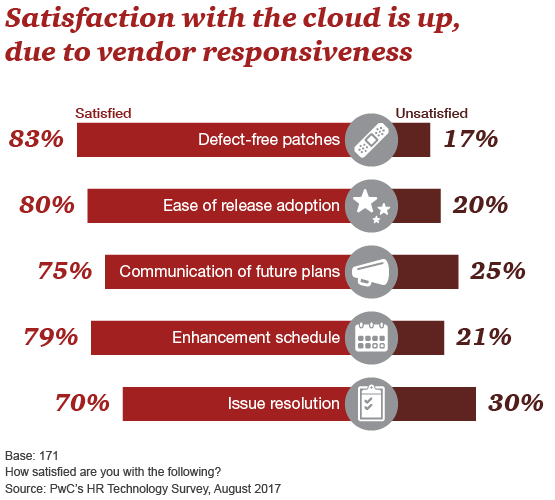In this fourth year of PwC's Global HR Technology Survey, we've looked at how cloud adoption is happening and how analytic applications are being prioritised to enable the Chief Human Resource Officer's agenda.
We found that organisations of all sizes continue to migrate their HR processes to the cloud at a record pace. Two years ago, 68% of organisations had at least one HR process in the cloud. In 2017, that number has climbed to 73%.
For those that still use on-premise applications (hosted within the organisation’s four walls) for core HR, nearly one-third are actively planning their migration to the cloud over the next 12–18 months.

What to consider if you're still on the fence
If it has been more than a year since your last assessment of the cloud as a viable option for core HR applications, it may be time for another look.
Steady year-over-year improvements from HR cloud vendors have increased satisfaction with software as a service overall.
Vendors are pushing new releases to customers anywhere from two to four times a year. More requirements are now met out-of-the box than ever before. Product defects are down sharply. And vendors have refined and improved their processes around development, release management, testing, and communication.


Deployments for analytics that aren't linked to your workforce strategy can lead to conflicting priorities and can hold you back from supporting the strategic direction of the enterprise.
What to change in your approach to HR analytics
We asked what needs to improve with HR technology support, planned implementations, or upgrades and HR analytics tops the list.
Organisations that are looking to take their analytics capabilities to the next level are seeking ways to:
- report insights beyond operational and compliance reports
- blend data from external sources
- select metrics and key performance indicators that matter and visualise them through easy to use dashboards
- apply big data concepts to HR questions
- leverage data in the cloud to support predictive analytical capabilities
- increase the use of HR analytics (e.g., strategic reports, dashboards, etc.) by HR business partners and leaders.
These analytic applications will start to blend machine learning with analytics so that increasingly more unstructured data can be used.
What's next for organisations when it comes to HR technology
The Chief Human Resources Officer has a wide range of technologies to help drive efficiencies and drive insights for the business. All leaders should get to know the opportunities these four technologies provide:
Platform as a Service (PaaS) extensions
Processes that would require a manual work-around or "one-off" application can now be automated and integrated as an extension of a cloud application using PaaS extensions. While our survey found that only 16% of HR cloud customers were taking advantage of this today, we predict the development of HR functionality extensions using PaaS will play a role in nearly all projects as more and more large enterprises-with unique and complex needs-adopt cloud technology.
Robotics Process Automation (RPA)
RPA is software that lays the foundation for machine learning and future applications of artificial intelligence. Where rules and logic can be applied, the software can conduct a task with far greater efficiency and with fewer errors. RPA is relatively easy to deploy and is particularly useful for HR tasks related to the processes that span multiple systems. For example, the action of onboarding, transferring, or off-boarding an employee may trigger process steps in benefits, payroll, and pension administration systems. An RPA application can be programmed to trigger these steps to increase efficiency.
Predictive analytics
If you can predict voluntary attrition you can prevent it. Reducing attrition by just 1% in an organisation of 5,000 employees with an attrition rate of 10% can save approximately $3.75 million. And that's just one use of predictive analytics. Building the statistical models to predict an outcome is the relatively easy task. More difficult is the behavioral change needed to act on the predictions. Testing each model is important, too. Pilot studies should be done to review the validity of predictions against actual behavior. Predictive analytics is a largely untapped opportunity today. In our survey, only 24% say predictive analytics is a priority for the next year.
Artificial Intelligence (AI)
Business leaders believe that AI will be a key contributor to gaining a business advantage in the future.1 Applications in HR can range from avoiding gender bias in recruiting to predicting turnover or profitability through sentiment analysis of call records, social media data, or other internal data. Most HR software vendors will soon release products that will help hiring managers decide which candidates to pursue for a given job and what attributes in their profile might be a good fit. They'll even suggest what interview questions to ask. The AI will be able to do this by analysing the data of employees who are already succeeding in the company and comparing these attributes with those in the candidate pool.
1 PwC, Bot.Me: A Revolutionary Partnership, April 2017.



